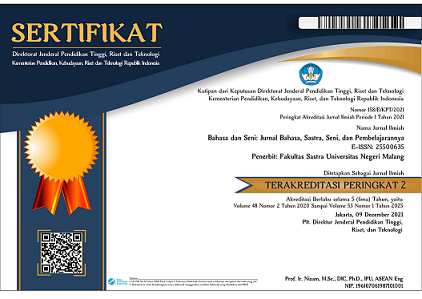EKSPLORASI HANTU PEREMPUAN DALAM SIHIR PEREMPUAN KARYA INTAN PARAMADITHA: TELAAH KONSTRUKSI FEMININITAS
Abstract
EXPLORING FEMALE GHOSTS IN INTAN PARAMADITHA’S SIHIR PEREMPUAN: A STUDY ON FEMININITY CONSTRUCTION
Abstract: Ghost stories as myth have been around for hundreds of years, both in oral or written forms. Literature has provided a space for urban legend. The most popular and legendary ghosts are usually female ghosts. These female ghosts appear not only to represent ghosts but they also carry certain feminine values from the authors. This study aims to investigate female ghosts on Sihir Perempuan, a collection of short stories written by Intan Paramaditha using feminist construction approach. Cixous’ (2008) theory of feminist writing and an approach to shift to the center are used as the study’s conceptual framework. The findings of this study include a paradox in the way Intan Paramaditha reconstructs femininity. In the effort of building femininity, female ghosts are portrayed as legends within patriarchal cultural power. The presence of female ghosts explores female bodies and psychology.
Keywords: female ghost, femininity, ghost story, myth, patriarchy
EKSPLORASI HANTU PEREMPUAN DALAM SIHIR PEREMPUAN KARYA INTAN PARAMADITHA: TELAAH KONSTRUKSI FEMININITAS
Abstrak: Cerita hantu sebagai sebuah mitos telah dikonsumsi publik sejak ratusan tahun yang lalu, baik secara lisan maupun tulisan. Dalam perkembangannya, karya sastra menjadi medium legenda urban. Hantu yang paling mengemuka ke ingatan publik adalah hantu perempuan. Kemunculan sosok hantu perempuan tidak hanya sekadar sebagai hantu tetapi juga sebagai sosok yang membawa nilai-nilai femininitas yang disematkan penulis. Penelitian ini membahas hantu perempuan pada kumpulan cerita pendek berjudul Sihir Perempuan karya Intan Paramaditha dengan telaah konstruksi femininitas. Kerangka konseptual yang digunakan adalah teori wacana Cixous (2008) tentang menulis feminin dan sebuah upaya pergeseran ke pusat. Temuan dari penelitian ini yaitu adanya paradoks dalam mengonstruksi femininitas yang dilakukan Intan Paramaditha. Dalam upaya melakukan konstruksi femininitas, hantu perempuan dihadirkan sebagai legenda di tengah kuasa budaya patriarki. Kehadiran hantu perempuan mengeksplorasi tubuh dan psikologis hantu perempuan.
Kata kunci: cerita hantu, hantu perempuan, femininitas, mitos, patriarki
Permalink/DOI: dx.doi.org/10.17977/um015v48i22020p167
Full Text:
PDFReferences
Abd. Manar, N. F. (2013). Islamizing the “Feminine, feminist and female” voices in three Malaysian short stories by Anglophone women writers. Intellectual Discourse, 8(2), 223-236.
Ahimsa-Putra, H. S. (1999). Strukturalisme Lévi-Strauss untuk arkeologi semiotik. Jurnal Humaniora, 9, 5-14.
Ahmadi, A. (2015). Perempuan dalam sastra lisan Pulau Raas: Kajian gender. Bahasa dan Seni: Jurnal Bahasa, Sastra, Seni, dan Pengajarannya, 43(1), 57-65.
Bray, A. (2004). Hélène Cixous: Writing and sexual difference. Palgrave Macmillan.
Cixous, H. (2008). White ink: Interviews on sex, text and politics. Acumen.
Halimah, U. (2017). Hantu perempuan Jawa dalam Alaming Lelembut sebagai representasi femme fatale. Sabda: Jurnal Kajian Kebudayaan, 10(2), 1-23.
Hollows, J. (2010). Feminisme, femininitas, dan budaya populer. Jalasutra.
Janti, N. (2017). Khazanah hantu Indonesia. Retrieved from https://historia.id/kultur/articles /khazanah-hantu-indonesia-voRq1
Kurnianto, E. A. (2014). Fungsi tokoh supernatural dan wacana tentang perempuan cerpen “Pintu Merah” dan “Jeritan dalam Botol” karya Intan Paramaditha. Salingka, Majalah Ilmiah Bahasa dan Sastra, 11(2), 210-219.
Kurnianto, E. A. (2016). Resistensi perempuan terhadap wacana ratu rumah tangga dalam cerpen Intan Paramaditha. ATAVISME, 19(1), 88-101.
Nirmalawati, W. 2008. Semiotika horror dalam poster film. Leksika: Jurnal Bahasa, Sastra, dan Pengajarannya, 2(2), 56-64.
Ras, J. J. (1985). Bunga rampai sastra Jawa mutakhir. Grafiti Pers.
Taufiq, A. (2010). Konstruksi politik tubuh dalam teks sastra poskolonial. ATAVISME, 13(1), 118-126.
Zeiny, E. 2019. Ecriture feminine: Feminism and nationalism in Seyyedeh Zahra Hosseini’s ‘One Woman’s War: Da. 3L: The Southeast Asian Journal of English Language Studies, 25(3), 115-125.
Zulkarnain, J. A. & Wiyatmi. 2018. Dekonstruksi femininitas dalam novel-novel karya Eka Kurniawan: Dari pekerjaan sampai kecantikan. Poetika: Jurnal Ilmu Sastra, 6(2), 109-121.
DOI: http://dx.doi.org/10.17977/um015v48i22020p167
Refbacks
- There are currently no refbacks.

This work is licensed under a Creative Commons Attribution 4.0 International License.

Dear Sir/Madam
We appreciate your continued confidence and trust in Bahasa dan Seni: Jurnal Bahasa, Sastra, Seni, dan Pengajarannya (JBS). In order to enhance the service, readability, and quality of JBS publications, we will be transitioning to a new website, https://citeus.um.ac.id/jbs, in collaboration with Digital Commons (Elsevier) starting in July 2024.
Sincerely
Yusuf Hanafi
(Editor in chief)















2.png)